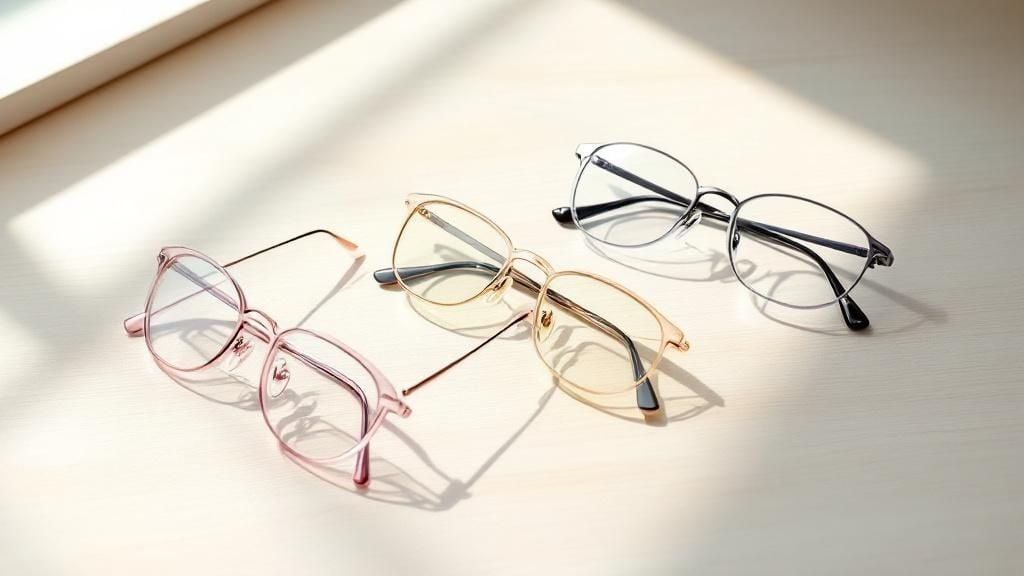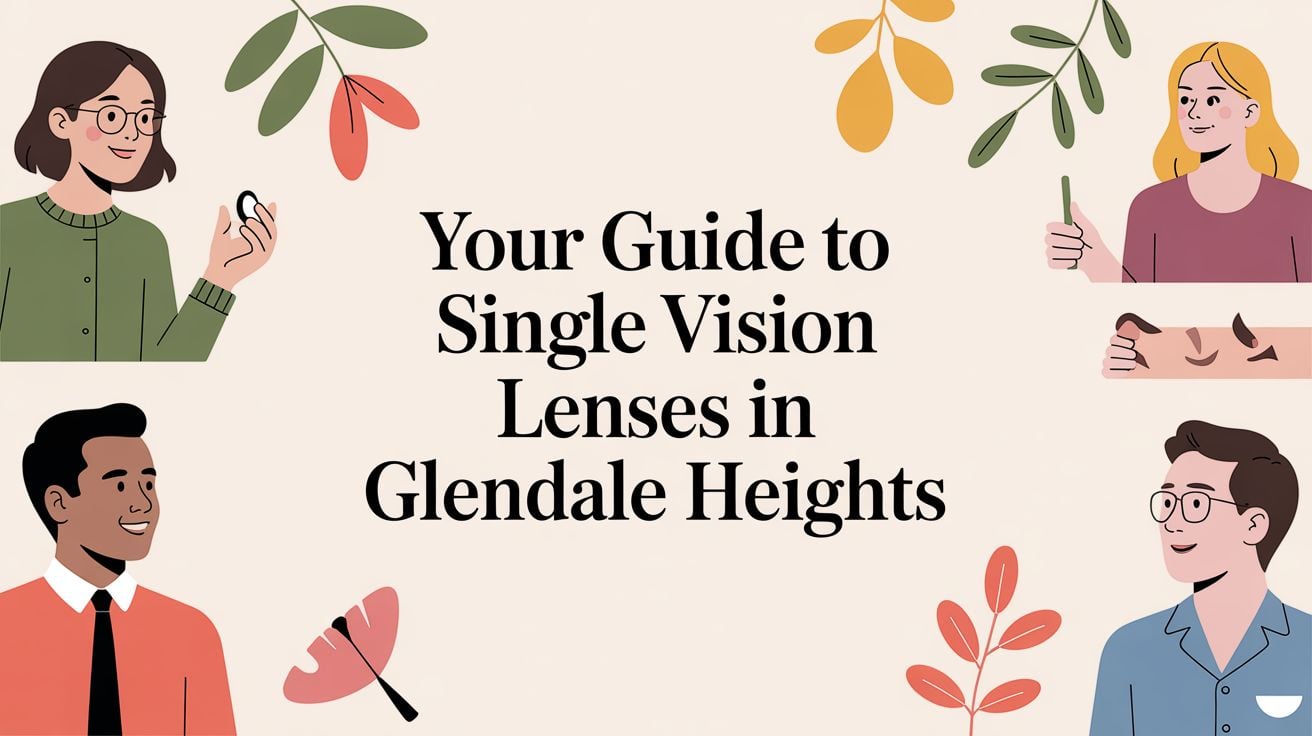Picking the right eyeglass lenses can feel like a maze, with so many options out there. For our neighbors here in Glendale Heights, understanding the difference between straightforward single-vision lenses and more advanced progressive designs is the first step toward perfect vision. The main players are single vision, bifocal, trifocal, and progressive lenses, and each one is built to handle different visual needs and lifestyles. It really all comes down to what your eyes need to see clearly.
Let's make this simple. Think of your lenses as the engine in a car—they're what really do the heavy lifting to give you that sharp, effortless vision. Here at iDoctor, our goal is to help our community in Glendale Heights find the ideal solution for their eyes, whether that means seeing clearly while driving down North Avenue at night or just reading a menu at your favorite local spot.
How you spend your day is a huge factor. The visual demands of a student at Glenbard West High School are completely different from those of someone staring at a computer screen all day. This guide will walk you through the most common types of eyeglass lenses, breaking it all down in simple, approachable language.
We'll look at how each type of lens functions and who it's really designed for. By the end, you'll have a much clearer picture of what you need, allowing you to pick lenses that fit perfectly into your daily routine.
The right lenses don't just help you see better—they enhance your quality of life by reducing eye strain and improving comfort throughout the day.
We're cutting through the technical jargon so you can feel totally confident about your choice. And while we're focused on lenses here, remember that the frames are just as important. Before you get too deep into lens specifics, it’s worth taking a look at how to choose eyeglasses that match your lenses and your personal style. We want to help you pair your perfect vision with frames you’ll love, from a sophisticated pair of Cartier to timeless Ray-Bans.
Understanding Single Vision Lenses
When it comes to eyeglasses, single vision lenses are the most common starting point for most people. Think of them as a lens with one single job to do: they correct your vision at one specific distance, and they do it exceptionally well.
Whether you need help seeing things far away or up close, a single vision lens provides a consistent, clear field of view from edge to edge. It's this straightforward, effective design that makes them the go-to choice for so many of our clients here in Glendale Heights.
Who Benefits from Single Vision Lenses?
Because they have one corrective power throughout the entire lens, they're perfect for tackling common vision problems. You're likely a great candidate for single vision lenses if you experience:
- Nearsightedness (Myopia): This is when distant objects, like signs on Glen Ellyn Road, appear blurry while things up close are clear.
- Farsightedness (Hyperopia): The opposite of myopia, where you might struggle to read a menu or a text message, but your distance vision is fine.
- Astigmatism: An imperfection in the eye's shape that can cause vision to be blurry at all distances.
These lenses aren't just for all-day wear, either. Many people get a dedicated pair of single vision glasses just for reading or to help reduce eye strain during long hours at the computer.
At iDoctor, our 30-minute detailed eye exams in Glendale Heights allow us to pinpoint your exact prescription. That level of precision is what makes sure your single vision lenses deliver the crispest, most comfortable vision imaginable.
No matter the reason you need them, these lenses offer a reliable and effective solution. The best part is, we can fit them into almost any frame you love—from affordable and timeless Ray-Ban styles to sophisticated Cartier designs—so you get perfect vision without compromising on style.
Bifocal and Trifocal Lenses: The Multi-Tasking Classics
At some point, many of us find that a single prescription just doesn't cut it anymore. Suddenly, you need help seeing things far away and up close. This is where bifocal and trifocal lenses come in—they are the original, practical solution for multi-distance vision correction.
Think of them as two or three pairs of glasses brilliantly merged into a single lens.
A bifocal lens is probably what you picture when you think of your grandparents' glasses. It has two distinct vision zones, separated by a noticeable line. The main, larger part of the lens is for distance vision, while a small segment at the bottom is dedicated to close-up work like reading a menu or a book.
The design is simple and effective. You look straight ahead to see across the street, then drop your gaze down to read. No need to swap glasses—it’s all right there. It's a straightforward and incredibly reliable way to get clear vision at two critical distances.
Trifocals: Adding That "In-Between" Power
Trifocals take this concept and add a third layer. They introduce a middle zone specifically for intermediate vision—that arm's-length distance where you view things like your computer monitor or the dashboard in your car.
Just like bifocals, these lenses have visible lines that separate the different prescription powers. While these lines can feel a bit abrupt at first and take some getting used to, both bifocals and trifocals have been trusted for decades for a reason: they work.
The visible lines are the defining feature of these traditional multi-focal lenses. If you're curious about how they stack up against modern, line-free options, our guide on progressive lenses vs. bifocals is a great next read.
The Seamless Clarity of Progressive Lenses
If you need glasses to see both up close and far away but can't stand the tell-tale line of bifocals, progressive lenses are your answer. They're a huge leap forward from older multifocal designs, giving you a smooth, invisible shift between different viewing distances. No lines, no jumps, just clear vision.
Think of it this way: bifocals are like a staircase, forcing your eyes to jump from one distinct prescription to another. Progressives, on the other hand, are like a gently sloping ramp. The lens power changes gradually from top to bottom, letting your eyes move naturally to find the right focus for reading a book, working on a computer, or driving down the road.
This seamless design is why so many of our Glendale Heights clients choose them for their designer frames. A beautiful pair of Tom Ford or Gucci glasses keeps its clean, modern look without a bifocal line breaking up the aesthetic. It’s the perfect marriage of performance and style.
Adapting to a New Way of Seeing
Now, there is a small learning curve. Getting used to the different "corridors" of vision in a progressive lens takes a little bit of practice. The key is learning to point your nose at what you're looking at, moving your head more than you might be used to.
Progressive lenses are a big part of why the prescription eyewear market is booming, now making up about 42% of all eyewear sales worldwide. With the industry pulling in around $15 billion annually, it's clear that people are investing in more advanced vision solutions.
Don't let the adjustment period deter you, though. It's usually quite short, and the reward is a much more natural and flexible way of seeing the world. For anyone making the switch, we have a great guide on adjusting to progressive lenses that will help you feel comfortable and confident in your new glasses in no time.
Specialty Lenses for Your Modern Lifestyle
Sometimes, standard vision correction just doesn't cut it. Your daily life is full of specific visual demands, and that’s where specialty lenses come in, offering targeted solutions to make every task clearer and more comfortable.
Think about how much time you spend on a computer. For our Glendale Heights patients who are at a desk all day, computer lenses can be a game-changer. They are designed specifically to sharpen your vision at the intermediate and near distances you use for screen work, helping to cut down on digital eye strain.
If you have a strong prescription, you’re probably familiar with the "coke bottle" effect of thick, heavy lenses. This is where high-index lenses shine. Made from a special material that bends light more effectively, they can be made much thinner and lighter than their standard counterparts. The result is a more comfortable and cosmetically appealing pair of glasses.
Advanced and Hybrid Lens Technology
Lens technology has come a long way, and now we can even combine different materials to create custom solutions for more complex vision needs. Hybrid lenses, for instance, merge the benefits of multiple materials into a single lens.
This infographic gives you a great overview of the foundational materials we work with to craft these lenses.
As you can see, each material brings something different to the table. This allows us to pick the perfect starting point based on your prescription and how you live your life.
To give you an idea of how specialized this field is, the U.S. market for advanced hybrid lenses was valued at around USD 411.6 million in 2024. They are a critical tool for managing conditions like keratoconus (accounting for 27.5% of cases) and significant astigmatism.
These custom solutions prove that modern eyewear is about so much more than just seeing clearly. It’s about enhancing every moment, from driving down Bloomingdale Road at night to working comfortably at your computer.
Choosing the right lens is all about matching the technology to your daily activities. It can seem like a lot, but understanding your options is the first step. To dive deeper, check out our Bloomingdale optical guide on choosing the right prescription lenses for your lifestyle.
Lens Coatings That Enhance Your Vision
If you think of your lenses as the engine of your glasses, then coatings are the high-performance upgrades that fine-tune them for your life. These are incredibly thin, invisible treatments applied to the lens surface that can dramatically improve how you see, how your glasses wear over time, and how comfortable your eyes feel. They aren't just bells and whistles; they're practical upgrades for real-world situations.
Take an anti-reflective (AR) coating, for example. This is an absolute must-have if you do any night driving. It cuts down on that blinding glare from headlights and streetlights, giving you a much clearer, crisper view of the road. Another go-to is a scratch-resistant coating, which acts like a protective shield to fend off the minor scuffs and scratches of daily life, keeping your vision clear for longer.
Advanced Coatings for Modern Needs
Let's face it, most of us spend a good chunk of our day staring at screens. That's where a blue light filtering treatment comes in. It can help ease the digital eye strain that leaves your eyes feeling tired and overworked, making your time on the computer or phone much more comfortable.
We also have coatings that do the work for you by adapting to your surroundings:
- Photochromic Lenses: You might know these as "Transitions." They darken automatically when you step into the sunlight, turning your regular glasses into sunglasses. They're perfect for a sunny afternoon walk through Camera Park.
- UV Protection: This is non-negotiable for eye health. It's an invisible shield that blocks the sun's damaging ultraviolet rays, essentially acting like sunscreen for your eyes.
The demand for these advanced lenses is huge. The global market was valued at around USD 18.6 billion in 2024 and continues to grow as new materials make lenses clearer and tougher than ever. You can read more about optical lens market trends here.
Think of these coatings as customizing a standard pair of lenses into a high-performance tool built just for you. They add clarity, protection, and convenience, all in one package.
Figuring out the right combination can feel a bit overwhelming, but that's what our team at iDoctor is here for. For a more detailed breakdown, check out our guide on how to choose the best lens coating package. At our Glendale Heights boutique, we’ll help you find the perfect lens and coating combination to match your lifestyle and your new favorite frames.
Frequently Asked Questions about Eyeglass Lenses
What’s the best lens for driving at night in Glendale Heights?
If you struggle with nighttime driving, especially on busy roads like Army Trail Road, an anti-reflective (AR) coating is a game-changer. It’s a special treatment we add to your lenses that cuts down on the blinding glare from headlights and streetlights. The result is much sharper, clearer, and more comfortable vision when you’re behind the wheel after dark.
I'm on a computer all day. Is there a lens to help with that?
Yes, absolutely. Digital eye strain is a real problem for many of our patients. We often recommend dedicated computer lenses to combat it. These lenses are optimized for the intermediate and up-close distances you use when looking at a screen, which helps relax your eyes, reduce fatigue, and keep you comfortable all day long.
Where can I find designer eyeglasses in Glendale Heights?
You can find a curated collection of luxury and designer eyewear right here at iDoctor. We carry sought-after brands like Cartier, Gucci, Tom Ford, and Oliver Peoples, alongside accessible favorites like Ray-Ban and Coach. We’ll help you pair the perfect high-performance lenses with a frame you truly love.
Does iDoctor in Glendale Heights take my vision insurance?
Yes, we are happy to accept all major vision insurance plans. Our friendly team can quickly check your coverage and explain your benefits for everything from your annual eye exam to a new pair of prescription glasses or contact lenses in Glendale Heights. Simply bring your insurance information with you to your appointment.





